Please post a few shots of your entries to the GB. I have a 1/72 Trumpeter Sea Fury to give away as a prize
Did you know that registration to Fighter Control is completely free and brings you lots of added features? Find out more....
USN GB Gallery
Moderator: Flyingmonster
-
Flyingmonster
- Moderator
- Posts: 13588
- Joined: Sun Oct 04, 2009 4:16 pm
- Location: Skipton, North Yorkshire
USN GB Gallery
Entries for the USN GB Group Build
Please post a few shots of your entries to the GB. I have a 1/72 Trumpeter Sea Fury to give away as a prize
Please post a few shots of your entries to the GB. I have a 1/72 Trumpeter Sea Fury to give away as a prize
Cheers
Boo boo (aka Jamie)
'The first time I ever saw a jet, I shot it down!' - Yeager
Boo boo (aka Jamie)
'The first time I ever saw a jet, I shot it down!' - Yeager
-
Flyingmonster
- Moderator
- Posts: 13588
- Joined: Sun Oct 04, 2009 4:16 pm
- Location: Skipton, North Yorkshire
Re: Hawk T1 - Goshawk T-45 Conversion
Hi All,
Made from Airfix Hawk T1, 1/72 scale with Model Alliance decals (MAS-729031) and Conversion kit from Airframe CS-167 Conversion set.
Building was ok, Milliput for the nose, scratch made slats, arrestor hook, extra winglets, air-brakes and body shaping, conversion kit for the front wheels, full flaps and arrestor hook mechanism.
Well its here, its taken a while and I have learnt shed loads. I'm happy with the overall result, though I have learnt alot of lessons for next time. Hopefully the final images do the T-45 Goshawk some justice. We have got a T-45C, No 163635-205, VX-23 'NAV AIR' from the United States Navy - Naval Air System Command (NASC) Strike Test.
So on with the images



On the starboard wing is "Navy", this isn't there on the real ones, it is blank, but I thought it looked odd blank.

There we go guys & gals - looking forward to your comments,
Steve
Posted by Steve - steve149c
Made from Airfix Hawk T1, 1/72 scale with Model Alliance decals (MAS-729031) and Conversion kit from Airframe CS-167 Conversion set.
Building was ok, Milliput for the nose, scratch made slats, arrestor hook, extra winglets, air-brakes and body shaping, conversion kit for the front wheels, full flaps and arrestor hook mechanism.
Well its here, its taken a while and I have learnt shed loads. I'm happy with the overall result, though I have learnt alot of lessons for next time. Hopefully the final images do the T-45 Goshawk some justice. We have got a T-45C, No 163635-205, VX-23 'NAV AIR' from the United States Navy - Naval Air System Command (NASC) Strike Test.
So on with the images



On the starboard wing is "Navy", this isn't there on the real ones, it is blank, but I thought it looked odd blank.

There we go guys & gals - looking forward to your comments,
Steve
Posted by Steve - steve149c
Cheers
Boo boo (aka Jamie)
'The first time I ever saw a jet, I shot it down!' - Yeager
Boo boo (aka Jamie)
'The first time I ever saw a jet, I shot it down!' - Yeager
-
Flyingmonster
- Moderator
- Posts: 13588
- Joined: Sun Oct 04, 2009 4:16 pm
- Location: Skipton, North Yorkshire
Re: USN GB - 1/60 Vought F7U-3 Cutlass
Revell kit, all straight out of the box, and used a light dirt wash for some slight sea weathering.



Posted by Dave - Davedubya



Posted by Dave - Davedubya
Cheers
Boo boo (aka Jamie)
'The first time I ever saw a jet, I shot it down!' - Yeager
Boo boo (aka Jamie)
'The first time I ever saw a jet, I shot it down!' - Yeager
-
Flyingmonster
- Moderator
- Posts: 13588
- Joined: Sun Oct 04, 2009 4:16 pm
- Location: Skipton, North Yorkshire
Re: USN GB - 1/72 Grumman Hellcat Bu.40467
I started to precis this and realised it would take forever. There is a full account of the aircraft and its pilots here;
http://www.americanmilitaryhistorymsw.c ... rd-m-hill/" onclick="window.open(this.href);return false;
Here is a picture of the aircraft, taken off of the net, at Duxford.
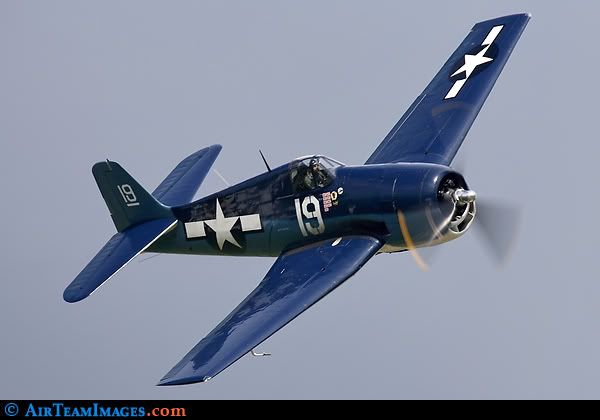
And here is a picture of Alex Vraciu posing with Hellcat Bu.40467
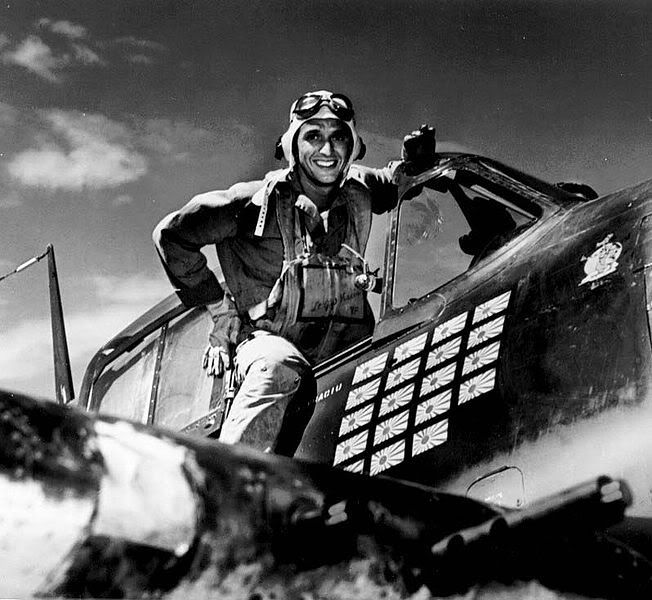
Here is my offering.
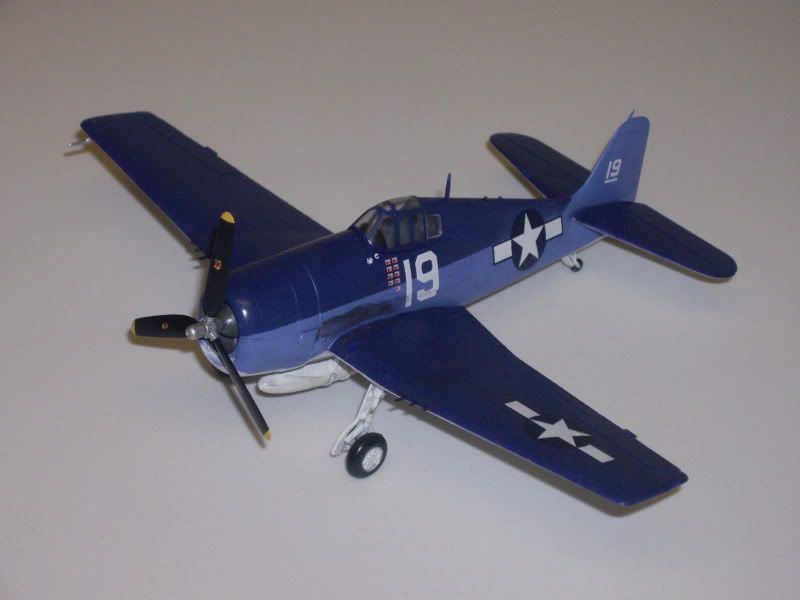

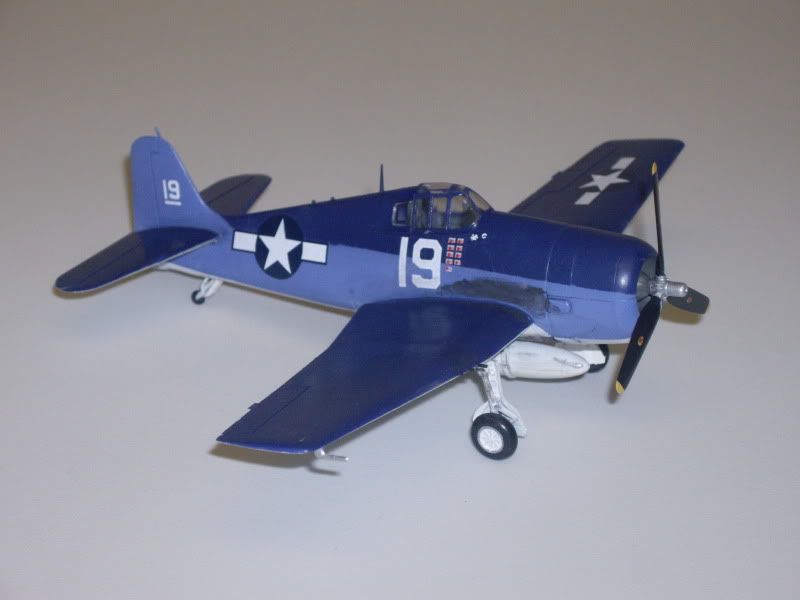
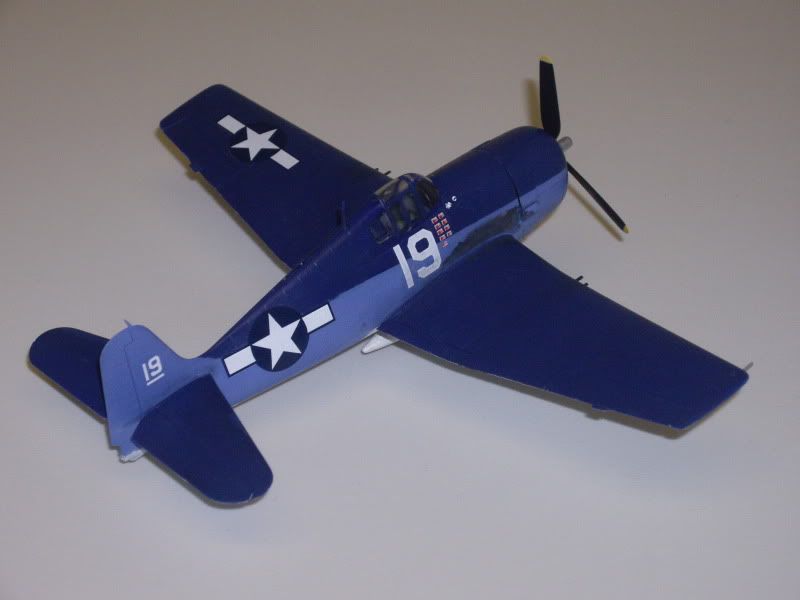



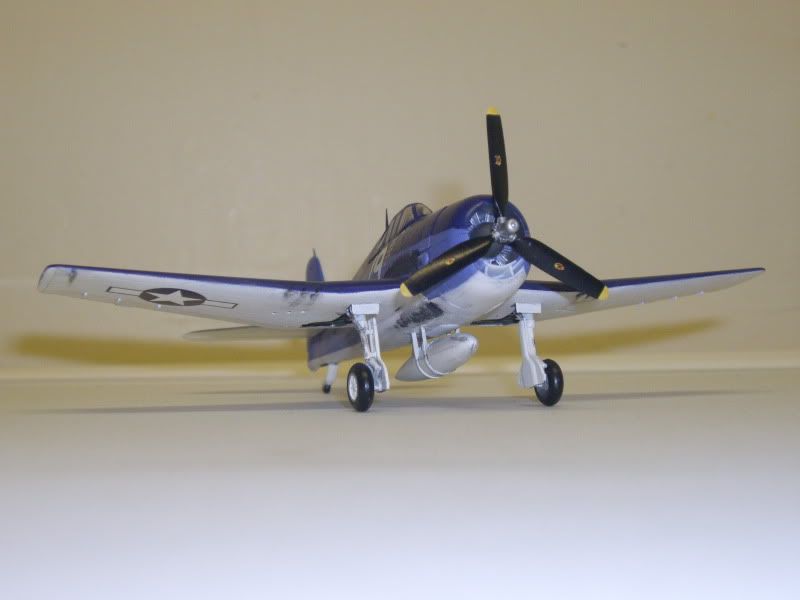
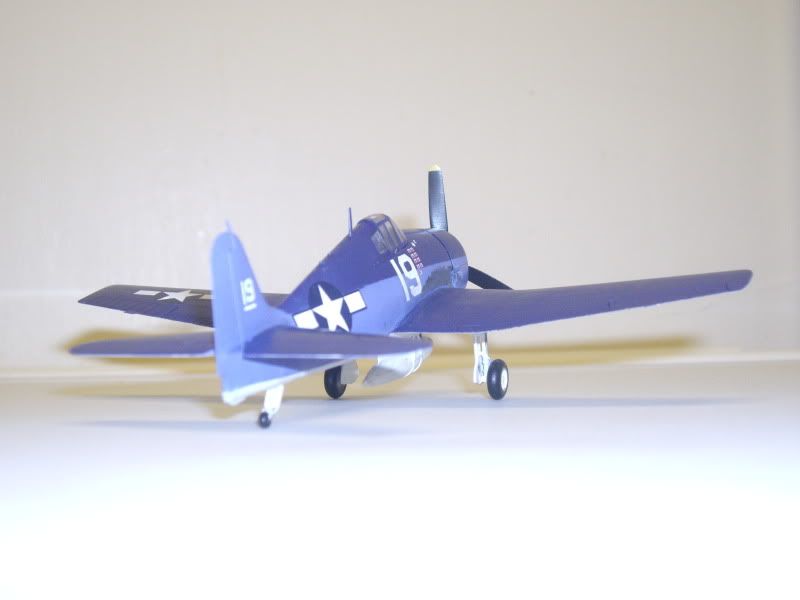
Posted by Steve - FTS
http://www.americanmilitaryhistorymsw.c ... rd-m-hill/" onclick="window.open(this.href);return false;
Here is a picture of the aircraft, taken off of the net, at Duxford.

And here is a picture of Alex Vraciu posing with Hellcat Bu.40467

Here is my offering.









Posted by Steve - FTS
Cheers
Boo boo (aka Jamie)
'The first time I ever saw a jet, I shot it down!' - Yeager
Boo boo (aka Jamie)
'The first time I ever saw a jet, I shot it down!' - Yeager
-
Flyingmonster
- Moderator
- Posts: 13588
- Joined: Sun Oct 04, 2009 4:16 pm
- Location: Skipton, North Yorkshire
Re: USN GB - 1/72 F4U-1D Corsair (VMF-212)
This kit is the rather old Testors kit and is tbh not very good. The kit lacks a cockpit, fits poorly and is very dated, however, at the cheap price I got it at on ebay makes up for it.
The aircraft is made in the scheme of aircraft F-107 which was flown by WWII ace Phillip Delong. Phillip DeLong entered the U.S. Marine Corps in Corpus Christi, Texas and graduated from his flight training on December 16, 1942. Delong was given his aviation wings and commissioned a Second Lieutenant and went on to serve in the Pacific during WWII and scored 11 aerial victories with VMF-212 flying the F4U-1 Corsair.
Here is the aircraft pictured during WWII.

The build itself;

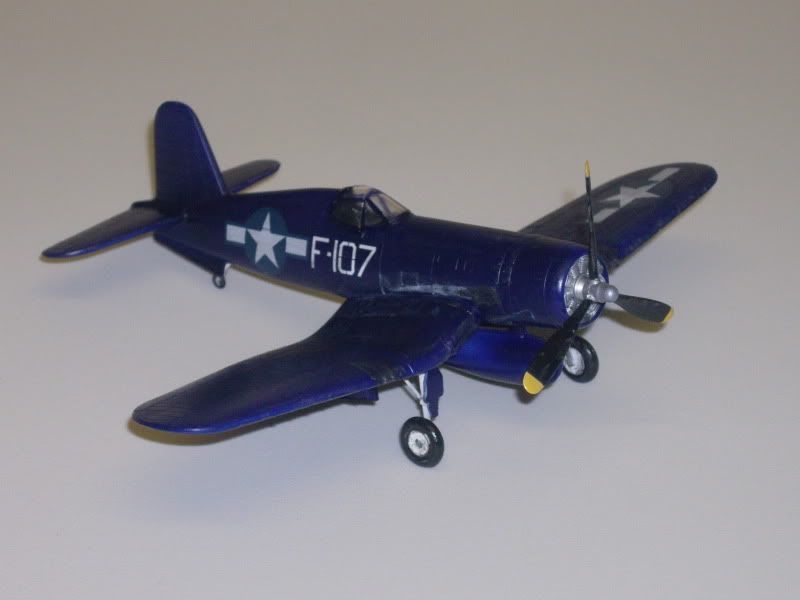
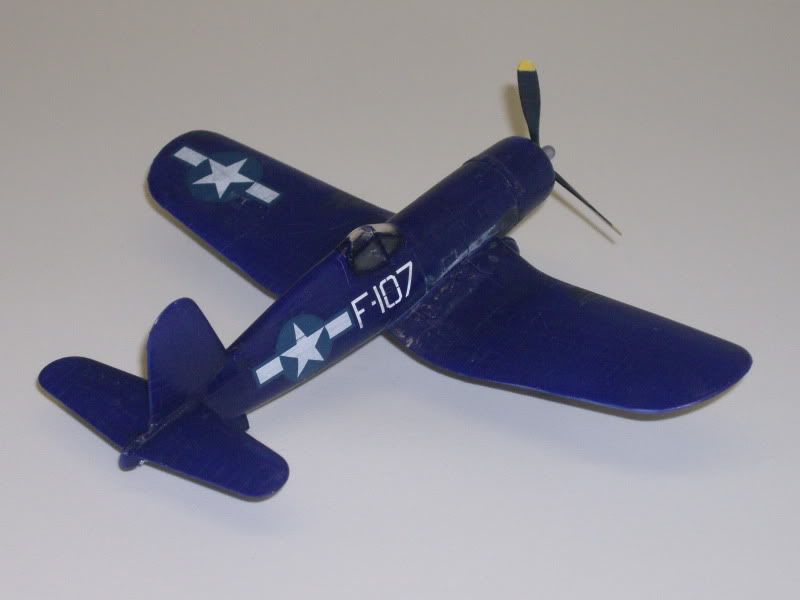

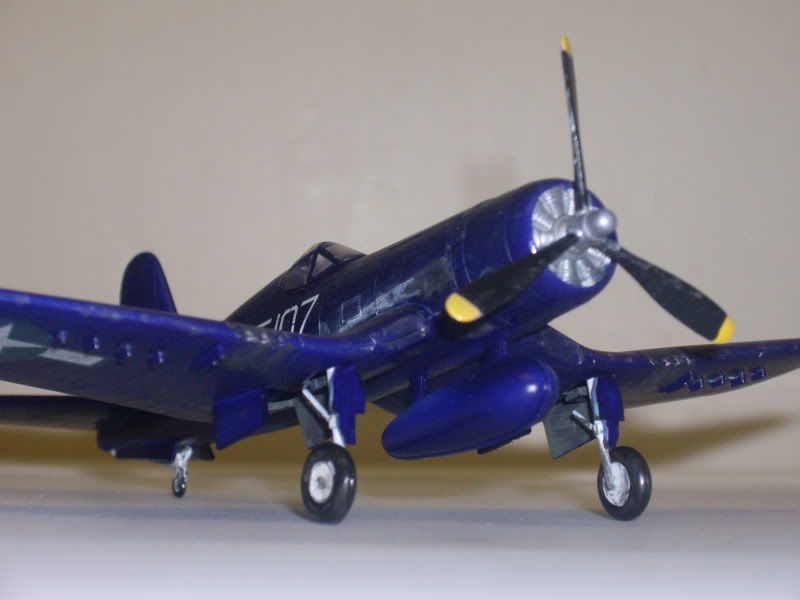
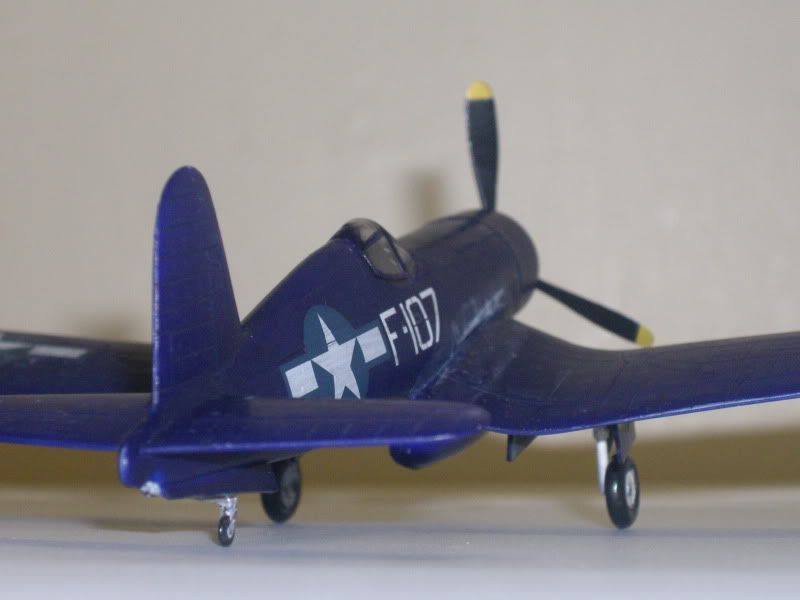
Posted by Steve - FTS
The aircraft is made in the scheme of aircraft F-107 which was flown by WWII ace Phillip Delong. Phillip DeLong entered the U.S. Marine Corps in Corpus Christi, Texas and graduated from his flight training on December 16, 1942. Delong was given his aviation wings and commissioned a Second Lieutenant and went on to serve in the Pacific during WWII and scored 11 aerial victories with VMF-212 flying the F4U-1 Corsair.
Here is the aircraft pictured during WWII.

The build itself;






Posted by Steve - FTS
Cheers
Boo boo (aka Jamie)
'The first time I ever saw a jet, I shot it down!' - Yeager
Boo boo (aka Jamie)
'The first time I ever saw a jet, I shot it down!' - Yeager
-
Flyingmonster
- Moderator
- Posts: 13588
- Joined: Sun Oct 04, 2009 4:16 pm
- Location: Skipton, North Yorkshire
Re: USN GB - 1/72 F6F-5 Hellcat 'Paper Doll'
This is a build of Revells boxing of the F6F-5 Hellcat, in the scheme of 'Paper Doll'. The aircraft was operated by VF-27, operating from the USS Princeton in 1944. The aircraft was flown by Ensign Robert Burnell.

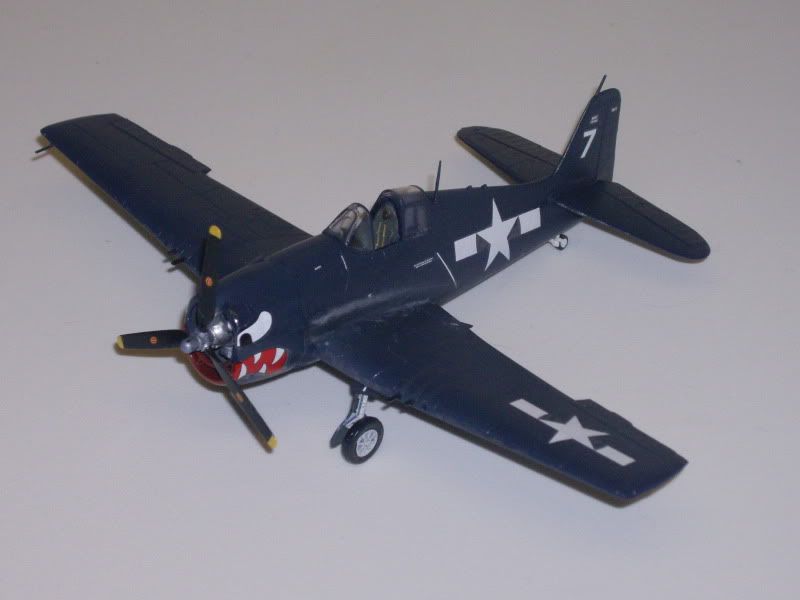

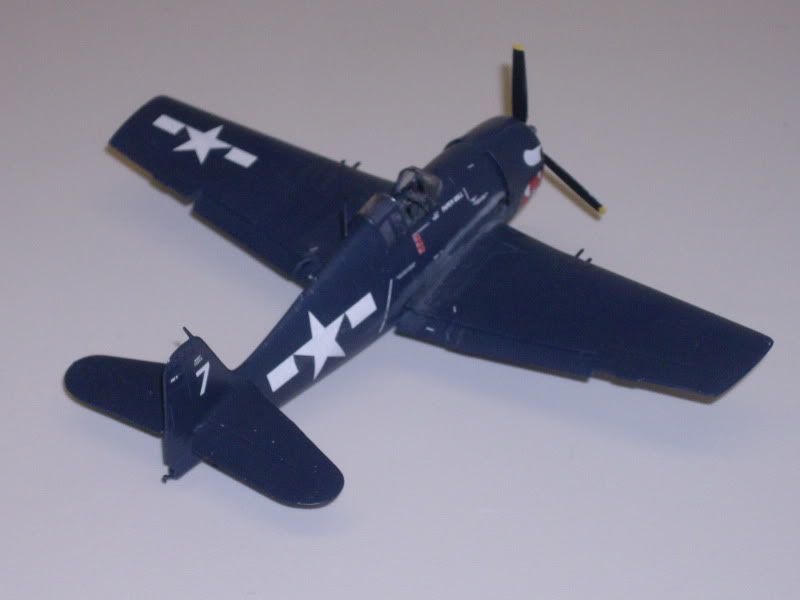
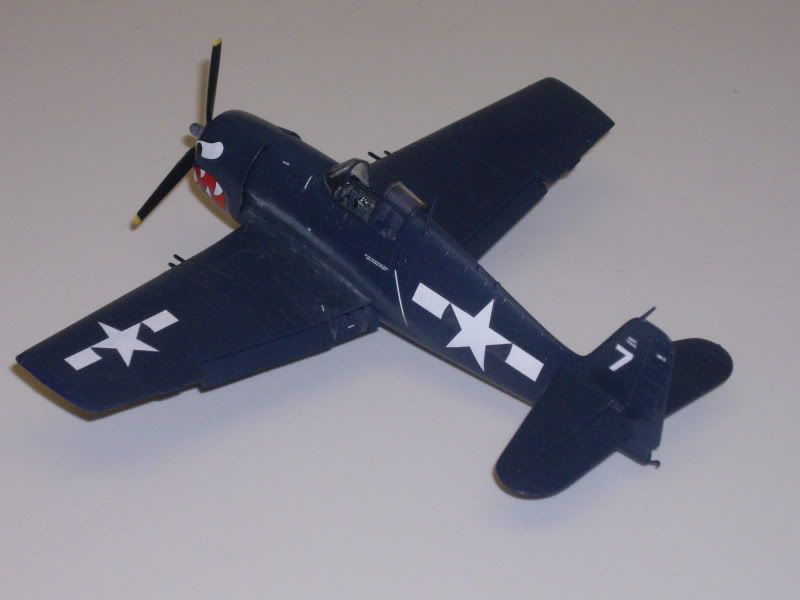
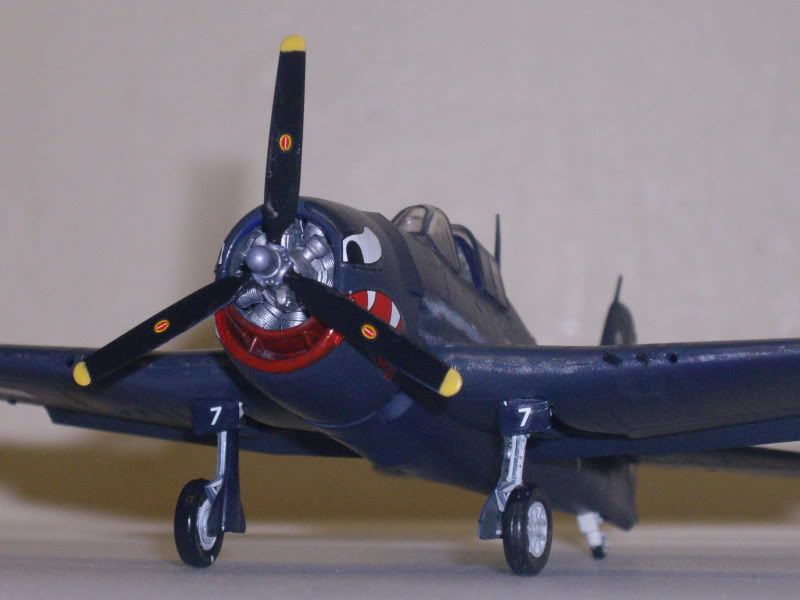
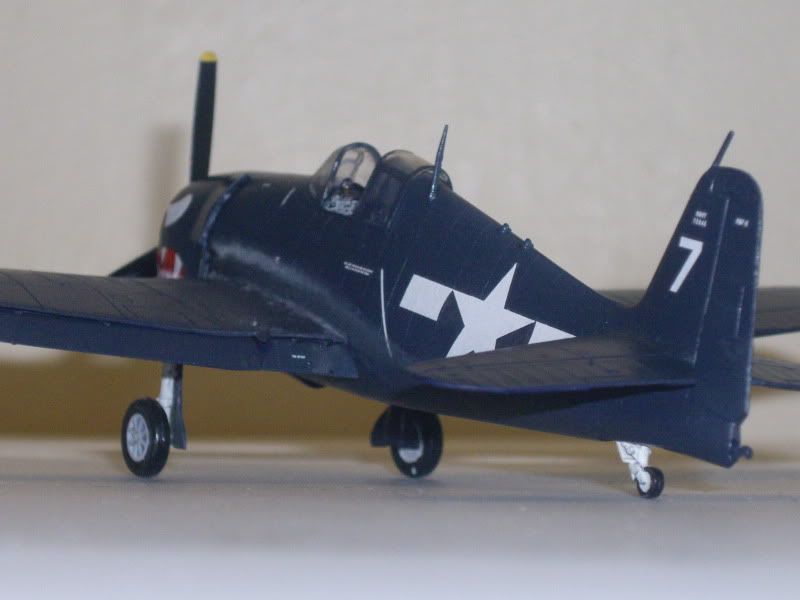
Posted by Steve - FTS







Posted by Steve - FTS
Cheers
Boo boo (aka Jamie)
'The first time I ever saw a jet, I shot it down!' - Yeager
Boo boo (aka Jamie)
'The first time I ever saw a jet, I shot it down!' - Yeager
-
Flyingmonster
- Moderator
- Posts: 13588
- Joined: Sun Oct 04, 2009 4:16 pm
- Location: Skipton, North Yorkshire
Re: USN GB - 1/72 F4U-4 Corsair (VMF-323)
This aircraft is painted in the scheme of Vance 'Bud' Younts aircraft during the Korean War, who at the time broke a US Navy rule, that was not to apply any nose art to any aircraft. Amongst the F4U pilots to see action during the early, critical, phase of the Korean War, 1Lt Vance 'Bud' Yount of VMF-323, embarked in USS Badoeng Strait (CVE-116) and then USS Sicily (CVE-118). He flew many missions against enemy troop concentrations in 1950-51. From the time the 'Death Rattlers' entered combat, its pilots were pushed to the limit due to the sheer number of targets in-theatre. They included the retreating remnants of the NKPA, as well as fresh Chinese troops pouring in during the winter of 1950-51.
'Bud' Yount, pictured with the aircraft.

The build;

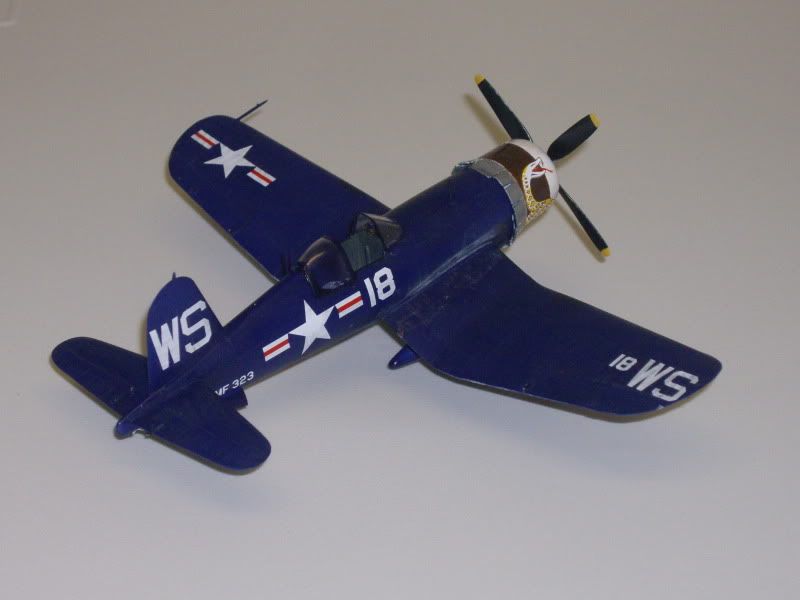
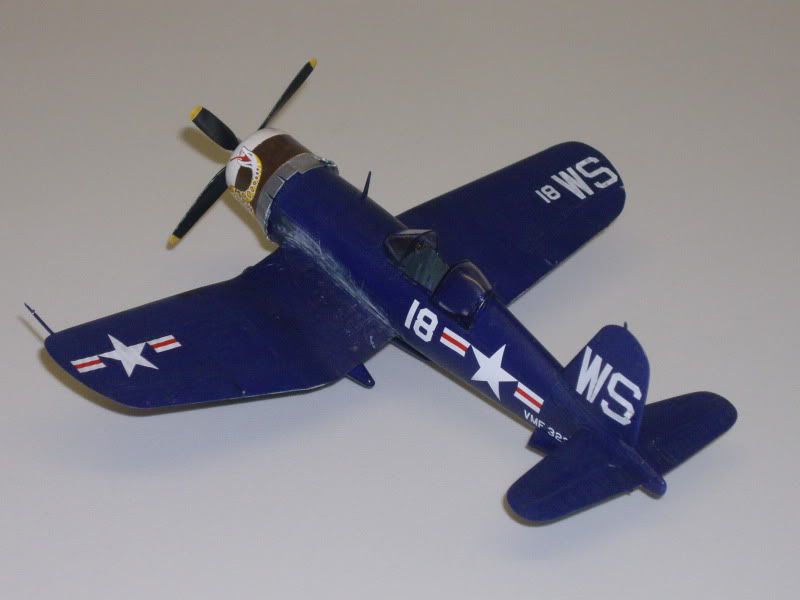

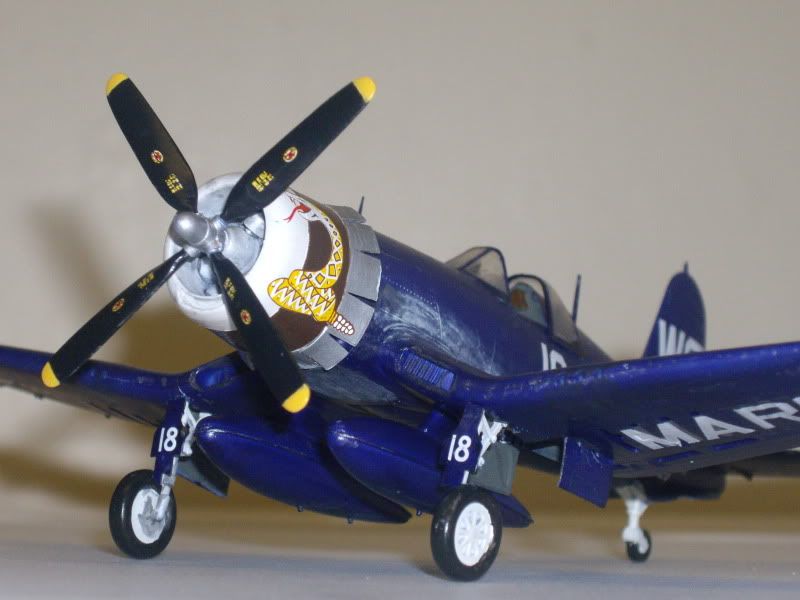
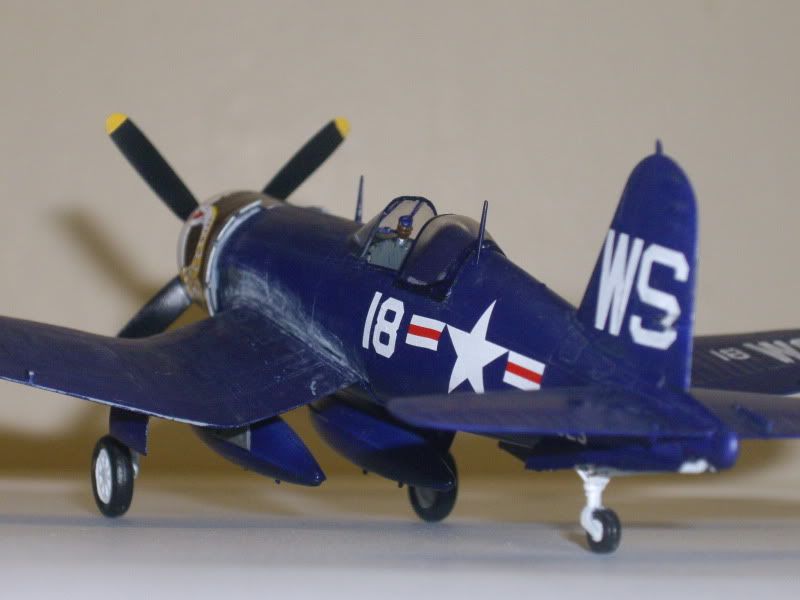
Posted by Steve - FTS
'Bud' Yount, pictured with the aircraft.

The build;






Posted by Steve - FTS
Cheers
Boo boo (aka Jamie)
'The first time I ever saw a jet, I shot it down!' - Yeager
Boo boo (aka Jamie)
'The first time I ever saw a jet, I shot it down!' - Yeager
-
Flyingmonster
- Moderator
- Posts: 13588
- Joined: Sun Oct 04, 2009 4:16 pm
- Location: Skipton, North Yorkshire
Re: USN GB - 1/72 SBD-3 Dauntless (USS Yorktown - Midway)
This aircraft is painted in the scheme worn by the aircraft piloted by Max Leslie during the Battle of Midway. Those who have seen the film the Battle of Midway, will recal an aircraft which jettisoned its bombs when the pilot flicked the arm switch. This is that aircraft. Undeterred by his lack of bomb load, Leslie led the squadron onward and was first to dive on the IJN Soryu, supplying suppressive machine gun fire in order for the other aircraft to get through to the target, which they did, sinking the carrier. The aircraft was flown from the USS Yorktown, which after a successful counter attack by the Japanese, was later sunk by a Japanese submarine.
The aircraft is available in diecast form from Corgi, and their product is what I used for referrence.

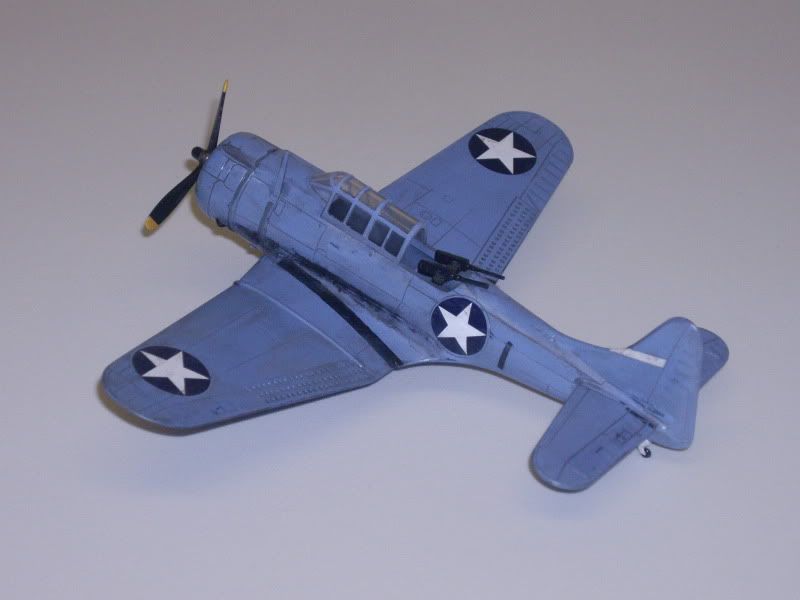
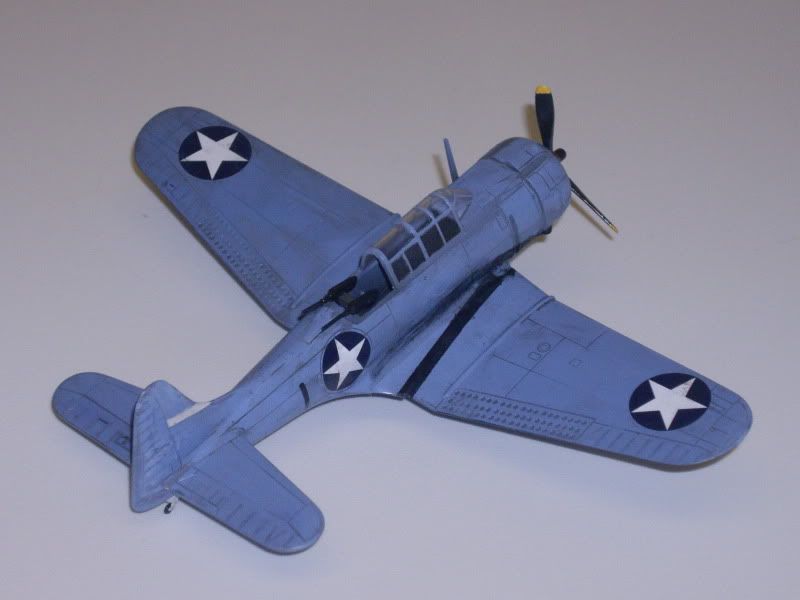
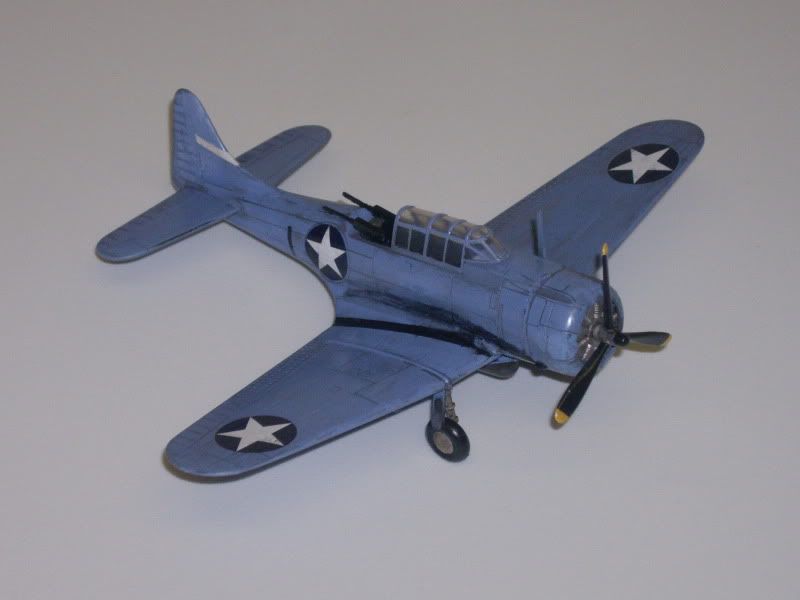
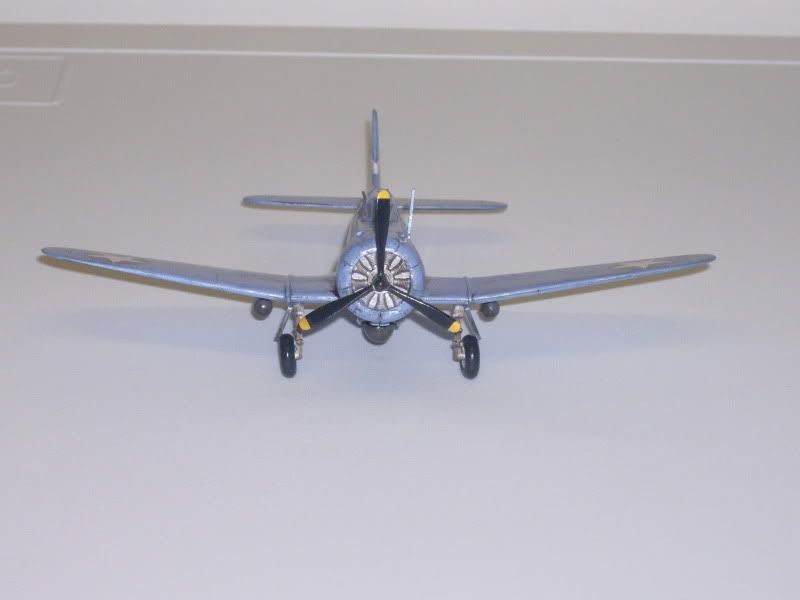
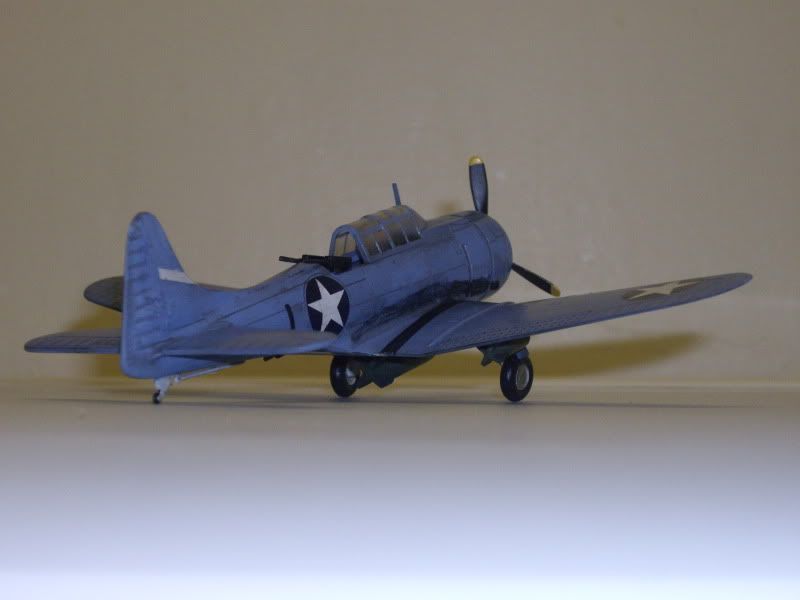
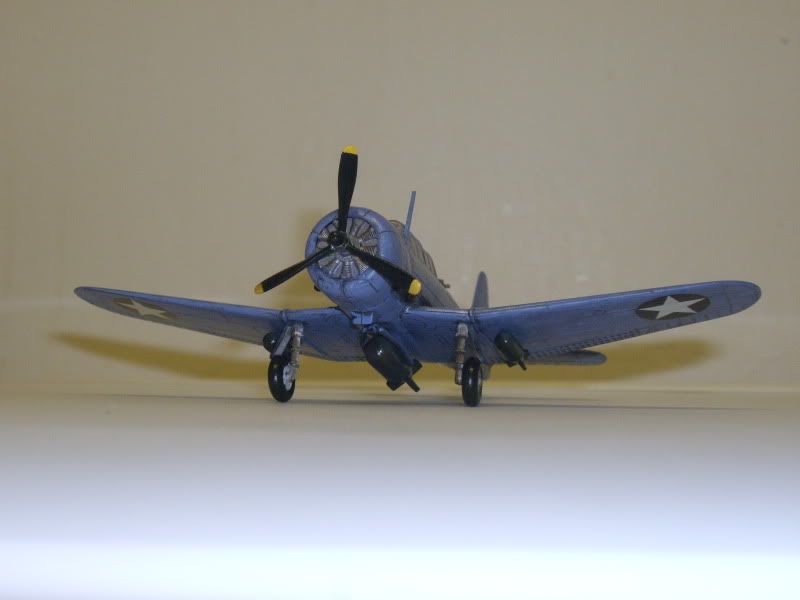
Posted by Steve - FTS
The aircraft is available in diecast form from Corgi, and their product is what I used for referrence.







Posted by Steve - FTS
Cheers
Boo boo (aka Jamie)
'The first time I ever saw a jet, I shot it down!' - Yeager
Boo boo (aka Jamie)
'The first time I ever saw a jet, I shot it down!' - Yeager
-
Flyingmonster
- Moderator
- Posts: 13588
- Joined: Sun Oct 04, 2009 4:16 pm
- Location: Skipton, North Yorkshire
Re: USN GB - 1/72 F4U-1 Corsair (VF-84 USS Bunker Hill 1945)
A bit of background on the aircraft and the carrier:
USS Bunker Hill
USS Bunker Hill (CV/CVA/CVS-17, AVT-9) was one of 24 Essex-class aircraft carriers built during World War II for the United States Navy. The ship, the second US Navy ship to bear the name, was named for the Battle of Bunker Hill. Bunker Hill was commissioned in May 1943, and served in several campaigns in the Pacific Theater of Operations, earning eleven battle stars and a Presidential Unit Citation. She was badly damaged in May 1945 by Japanese kamikaze attacks, with the loss of hundreds of her crew, becoming one of the most heavily damaged carriers to survive the war.
After the attack she returned to the U.S. mainland for repairs and was decommissioned in 1947. While in reserve she was reclassified as an attack carrier (CVA), then an antisubmarine carrier (CVS), and finally an Auxiliary Aircraft Landing Training Ship (AVT), but was never modernized and never saw active service again. Bunker Hill and Franklin were the only Essex-class ships never recommissioned after World War II.
Stricken from the Naval Vessel Register in 1966, she served as an electronics test platform for many years in San Diego bay, and was sold for scrap in 1973. An effort to save her as a museum ship in 1972 was unsuccessful.
VF-84
On 1 May 1944, the first VF-84, known as "Wolf Gang" was established. It was formed around a nucleus of veterans of VF-17 (the original "Jolly Rogers"), an F4U Corsair squadron land-based in the Solomon Islands in late 1943 and early 1944. The new squadron's commanding officer was Lt. Cdr. Roger R.Hedrick, former executive officer of VF-17. VF-84 was assigned to the USS Bunker Hill (CV-17), the original home of VF-17. As part of Task Force 58, the carrier and its air group (including VF-84) participated in the final drive across the central Pacific. VF-84 took part in the invasion of Iwo Jima; raids on Tokyo and other targets in Japan; the discovery and sinking of the Japanese battleship Yamato and support of the invasion of Okinawa, including combat air patrol over the invasion fleet to defend against kamikaze attack, ground support, and combat air patrol over targets on Okinawa.
On 11 May 1945, while off Okinawa, two Japanese kamikazes struck the carrier in quick succession. A bomb carried by one penetrated to the pilots' ready room. Twenty-two members of VF-84 lost their lives in the attack. Both the carrier (then the flagship) and its air group were knocked out of the war. Although VF-84 was reformed in July as an F6F Hellcat squadron, the war ended while it was still at its base in the United States. The squadron was disestablished on 8 October 1945.
While with the task force, the pilots of VF-84 were credited with 92 shootdowns for a loss of 4 Corsairs in air-to-air combat, a ratio of 48:1. Nine of the squadron's pilots became aces.
Here's a picture of the real aircraft on the deck of the USS Bunker Hill.
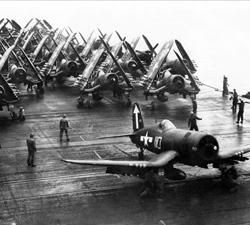
The build.
This is my first entry for this GB. I tried some new techniques with the weathering which included using a 'cue tip' and black chalk to dirty the gun ports.
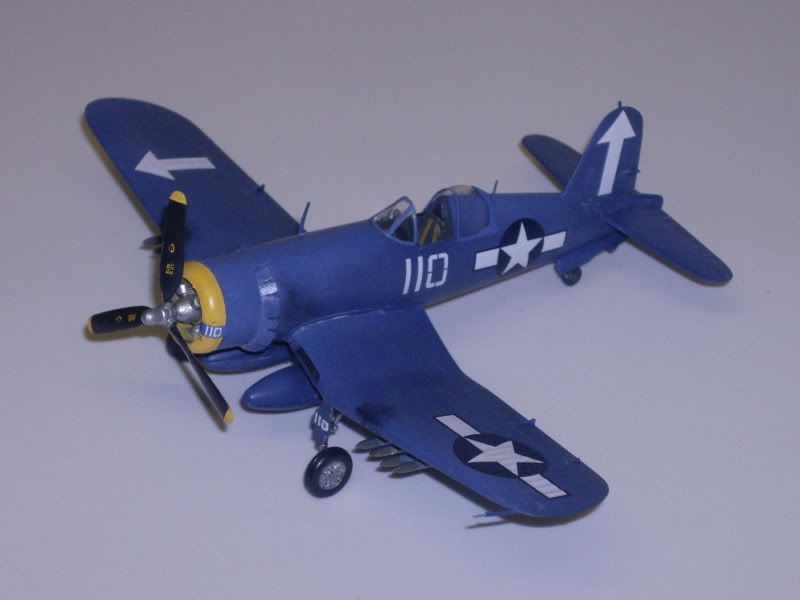
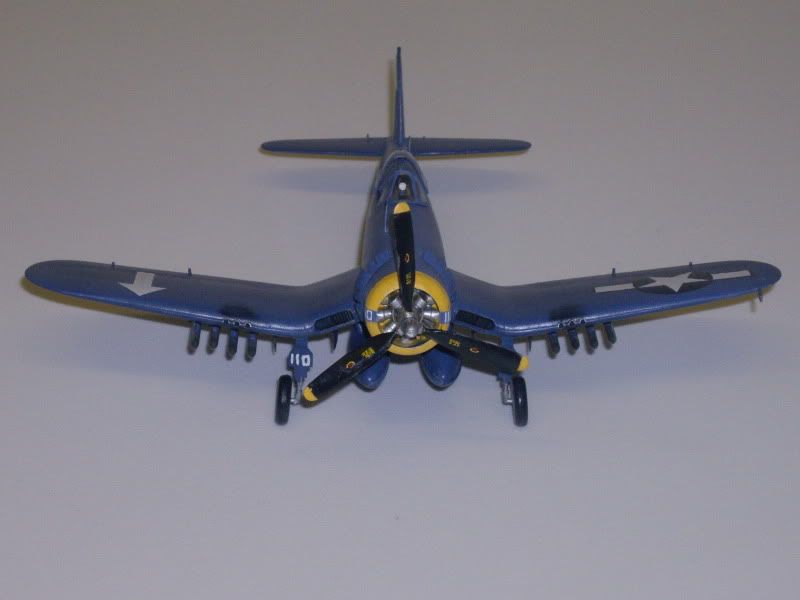
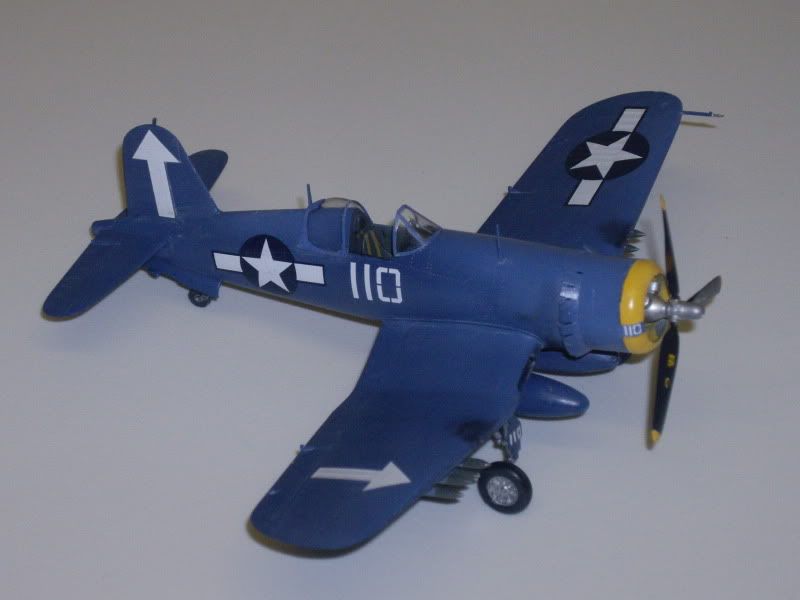
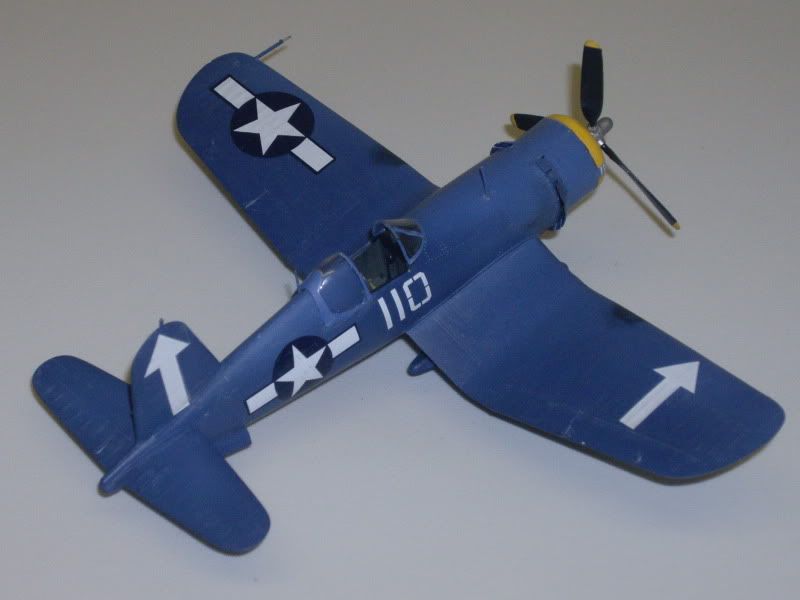
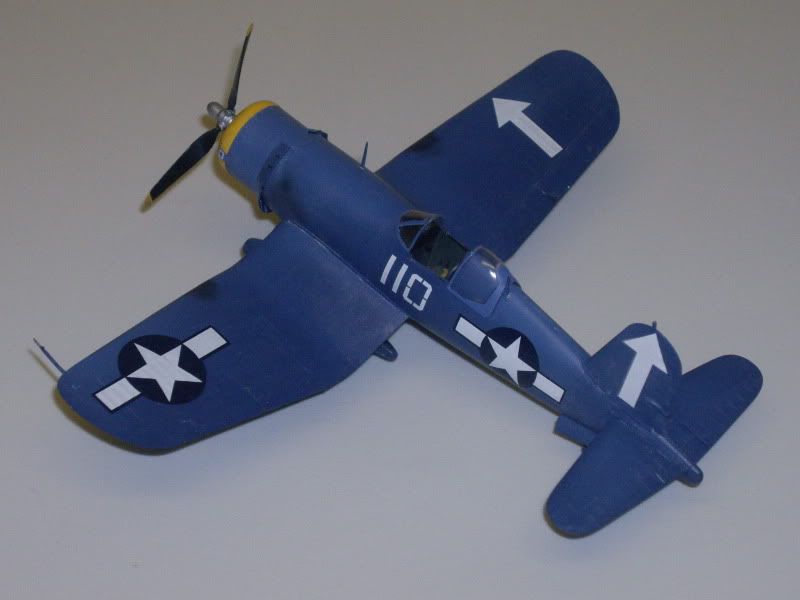

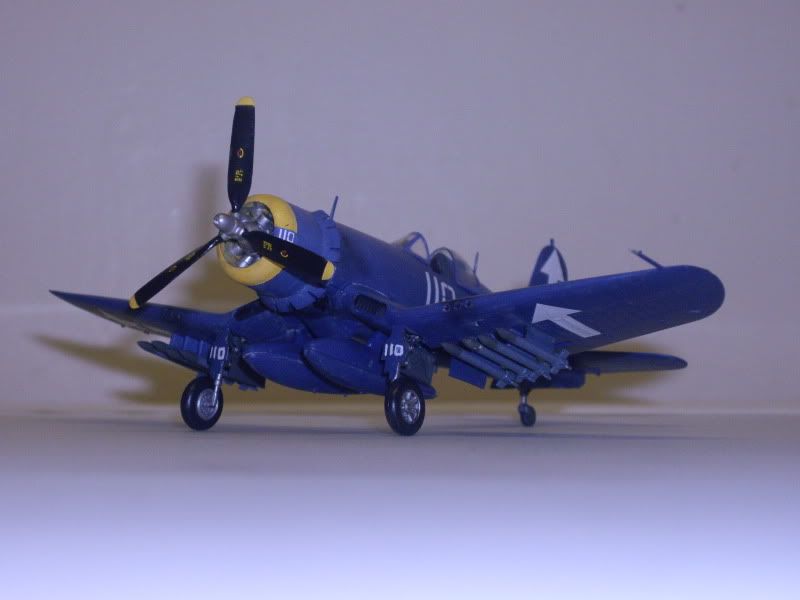

Without the flash.
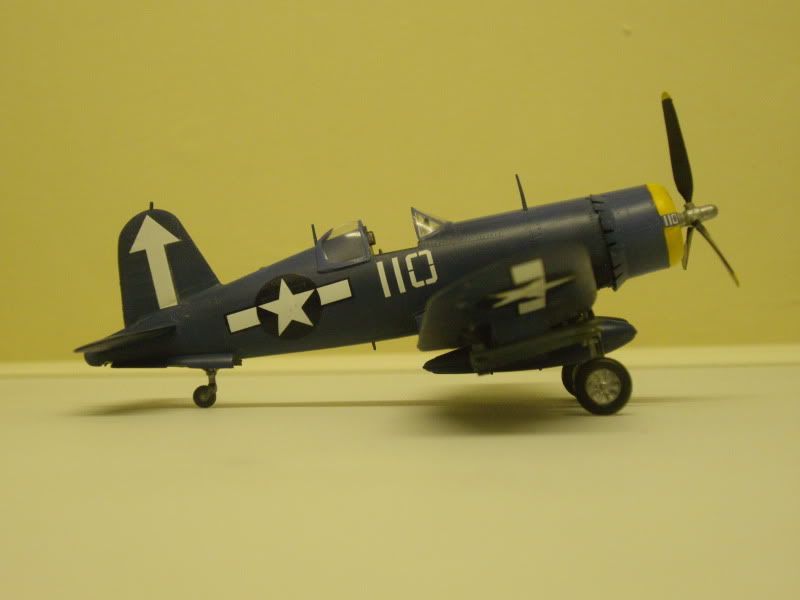

Posted by Steve - FTS
USS Bunker Hill
USS Bunker Hill (CV/CVA/CVS-17, AVT-9) was one of 24 Essex-class aircraft carriers built during World War II for the United States Navy. The ship, the second US Navy ship to bear the name, was named for the Battle of Bunker Hill. Bunker Hill was commissioned in May 1943, and served in several campaigns in the Pacific Theater of Operations, earning eleven battle stars and a Presidential Unit Citation. She was badly damaged in May 1945 by Japanese kamikaze attacks, with the loss of hundreds of her crew, becoming one of the most heavily damaged carriers to survive the war.
After the attack she returned to the U.S. mainland for repairs and was decommissioned in 1947. While in reserve she was reclassified as an attack carrier (CVA), then an antisubmarine carrier (CVS), and finally an Auxiliary Aircraft Landing Training Ship (AVT), but was never modernized and never saw active service again. Bunker Hill and Franklin were the only Essex-class ships never recommissioned after World War II.
Stricken from the Naval Vessel Register in 1966, she served as an electronics test platform for many years in San Diego bay, and was sold for scrap in 1973. An effort to save her as a museum ship in 1972 was unsuccessful.
VF-84
On 1 May 1944, the first VF-84, known as "Wolf Gang" was established. It was formed around a nucleus of veterans of VF-17 (the original "Jolly Rogers"), an F4U Corsair squadron land-based in the Solomon Islands in late 1943 and early 1944. The new squadron's commanding officer was Lt. Cdr. Roger R.Hedrick, former executive officer of VF-17. VF-84 was assigned to the USS Bunker Hill (CV-17), the original home of VF-17. As part of Task Force 58, the carrier and its air group (including VF-84) participated in the final drive across the central Pacific. VF-84 took part in the invasion of Iwo Jima; raids on Tokyo and other targets in Japan; the discovery and sinking of the Japanese battleship Yamato and support of the invasion of Okinawa, including combat air patrol over the invasion fleet to defend against kamikaze attack, ground support, and combat air patrol over targets on Okinawa.
On 11 May 1945, while off Okinawa, two Japanese kamikazes struck the carrier in quick succession. A bomb carried by one penetrated to the pilots' ready room. Twenty-two members of VF-84 lost their lives in the attack. Both the carrier (then the flagship) and its air group were knocked out of the war. Although VF-84 was reformed in July as an F6F Hellcat squadron, the war ended while it was still at its base in the United States. The squadron was disestablished on 8 October 1945.
While with the task force, the pilots of VF-84 were credited with 92 shootdowns for a loss of 4 Corsairs in air-to-air combat, a ratio of 48:1. Nine of the squadron's pilots became aces.
Here's a picture of the real aircraft on the deck of the USS Bunker Hill.

The build.
This is my first entry for this GB. I tried some new techniques with the weathering which included using a 'cue tip' and black chalk to dirty the gun ports.








Without the flash.


Posted by Steve - FTS
Cheers
Boo boo (aka Jamie)
'The first time I ever saw a jet, I shot it down!' - Yeager
Boo boo (aka Jamie)
'The first time I ever saw a jet, I shot it down!' - Yeager
-
Flyingmonster
- Moderator
- Posts: 13588
- Joined: Sun Oct 04, 2009 4:16 pm
- Location: Skipton, North Yorkshire
USN GB - 1/72 F4U-4 Corsair (VMFT-20)
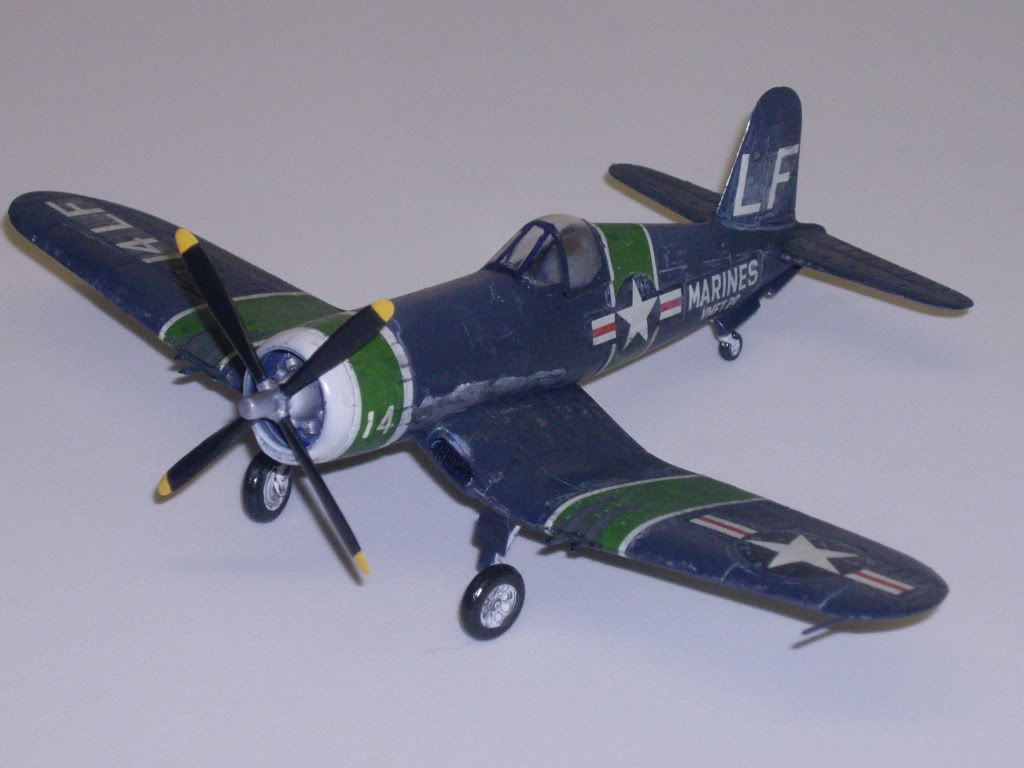
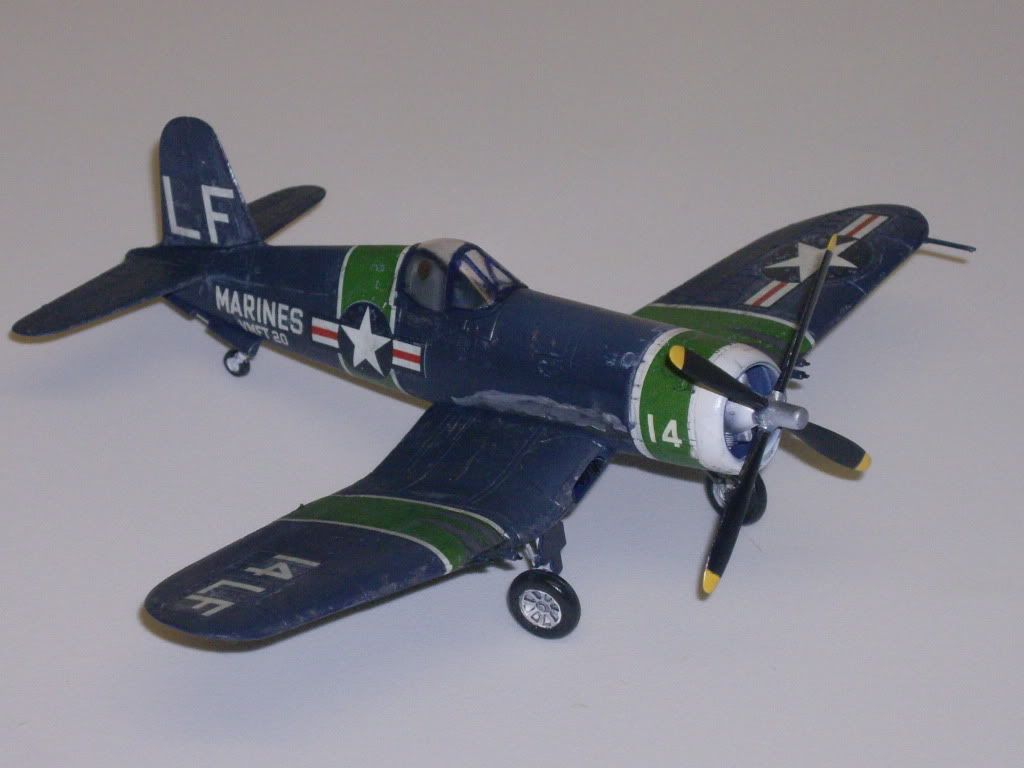

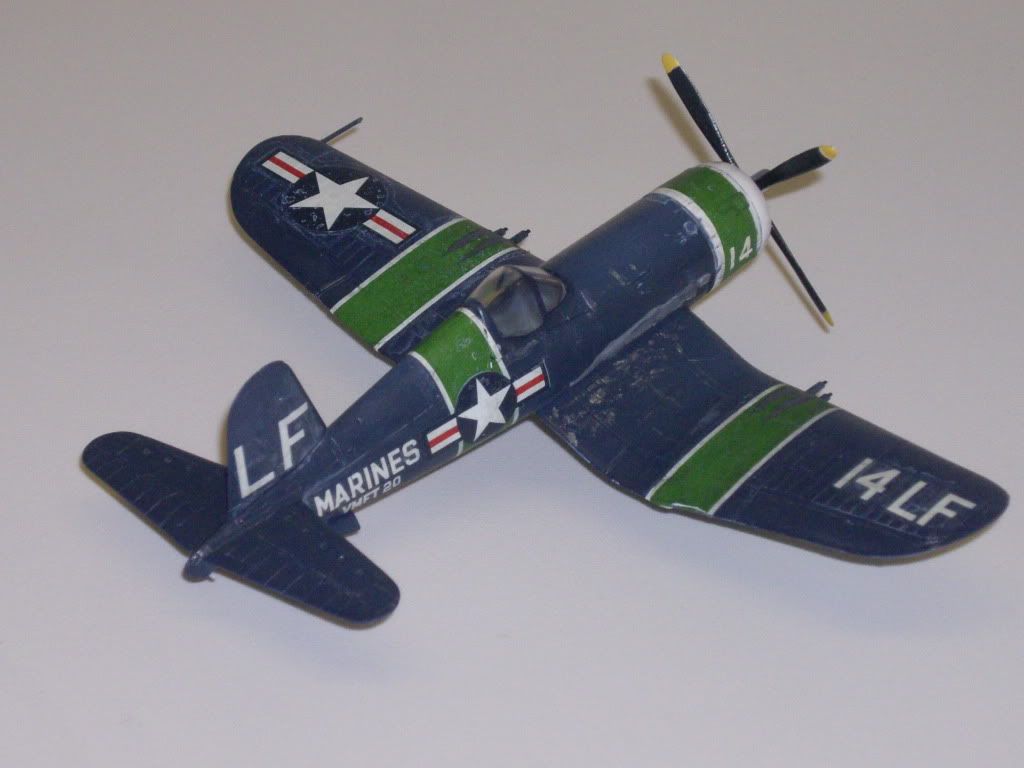
Posted by Steve!
Cheers
Boo boo (aka Jamie)
'The first time I ever saw a jet, I shot it down!' - Yeager
Boo boo (aka Jamie)
'The first time I ever saw a jet, I shot it down!' - Yeager
-
tc2324
Re: USN GB Gallery
Model depicting F-14, BuNo 159610, from VF-32 `Swordsman` shortly after landing on the 4th January 1989 after shooting down a Libyan MiG-23 `Flogger` with a AIM-9 Sidewinder during what was to become known as the Gulf of Sidra Incident.
At the request of the National Air and Space Museum, the Navy provided BuNo 159610 to its Udvar-Hazy location near Dulles International Airport for public display on the September 30th 2006.




At the request of the National Air and Space Museum, the Navy provided BuNo 159610 to its Udvar-Hazy location near Dulles International Airport for public display on the September 30th 2006.




Last edited by Guest on Sat Jan 21, 2012 4:03 pm, edited 1 time in total.
Re: USN GB Gallery
F/A-18A Hornet 'Blue Angels'
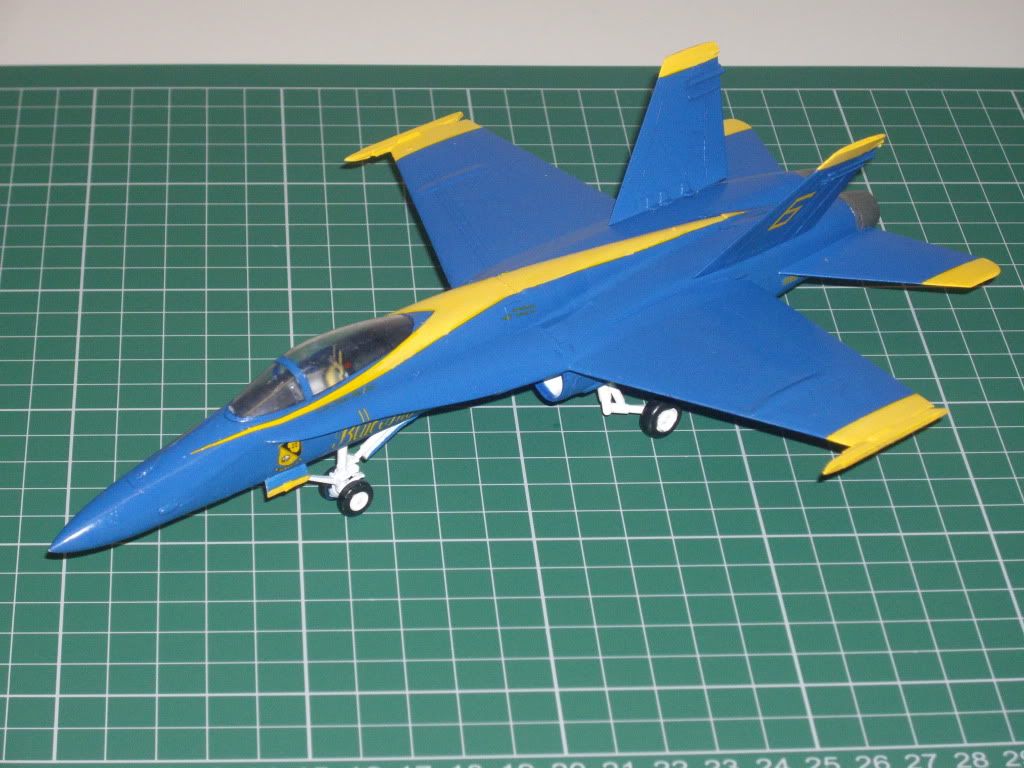
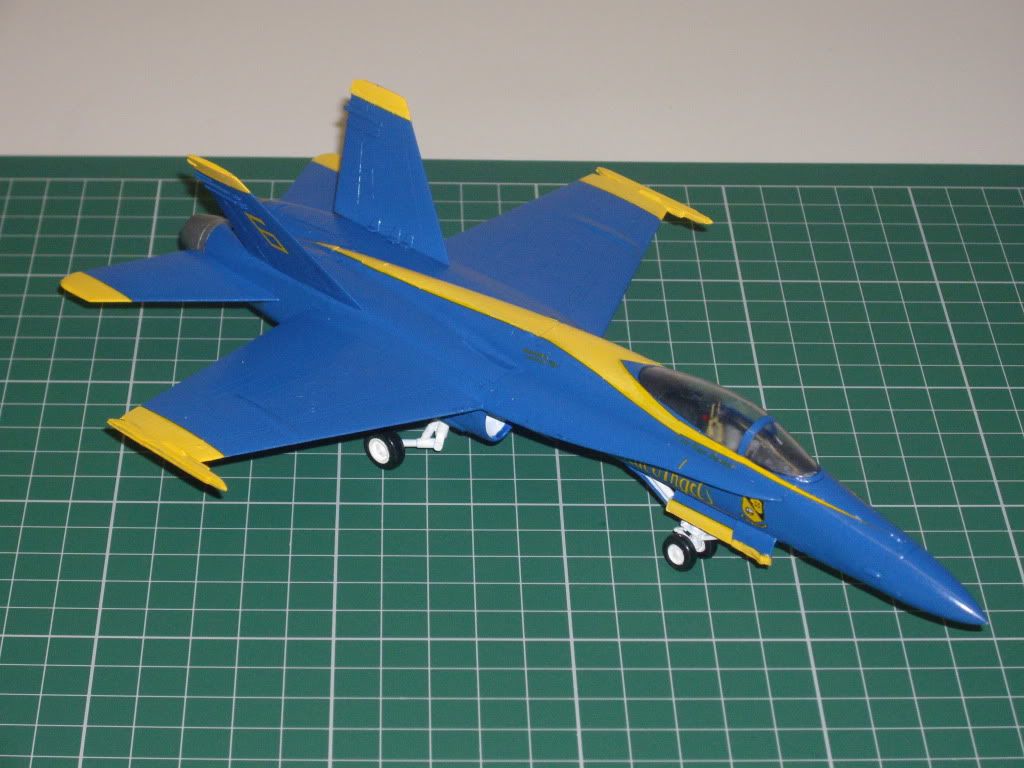
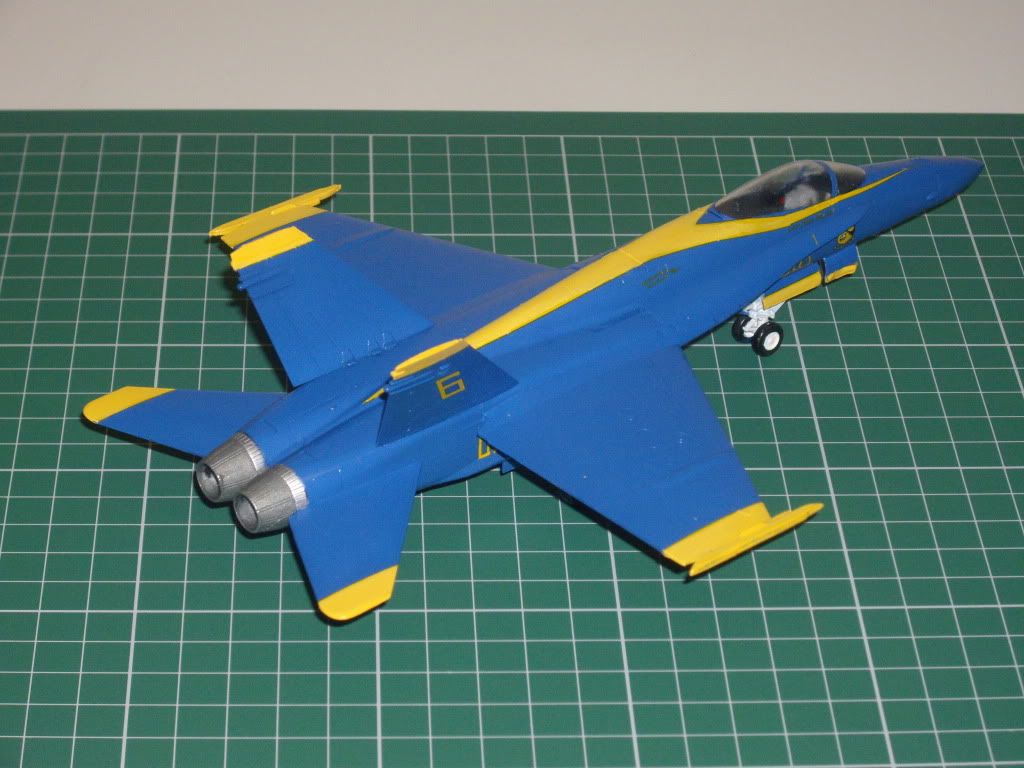

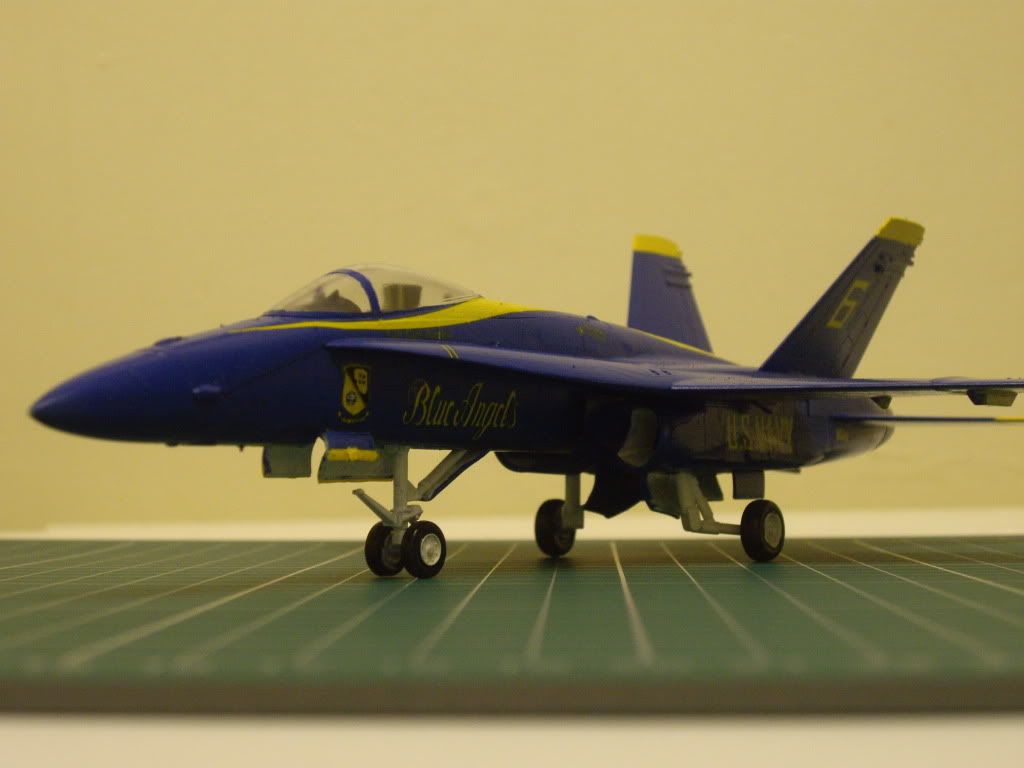





http://stevenharrisongreen.wixsite.com/shgp
facebook.com/stevenharrisongreenphotography
instagram.com/shgphotography86/
facebook.com/stevenharrisongreenphotography
instagram.com/shgphotography86/
Re: USN GB Gallery
Hi All,
Built almost OOB, just some EZ Line for the Aerial. A good build with not too much filling - this is the first every aircraft for my airbrush, so I am pleased with the results. I love the colours too! I love Tamiya's new colour, XF-85, Black Rubber - it looks great on tyres and the walkway.
The Douglas Devastator TBD-1 was almost retired at the entry of America into the war, however they became part of almost every major sea battle. Carrying a single torpedo, and a crew of three, with one as a rear gunner, and a single forward gun.
Kit: Airfix A02034 1:72
Model: Douglas Devastator TBD-1
Colours: Humbrol Enamel Matt Yellow (24), Tamiya XF-16 Flat Alumium, Tamiya XF-85 Black Rubber, Tamiya X-7 Red, Tamiya XF-2 White
Decals: Kit supplied
Others: Klear
Onto the model;








I decided not to weather this model as I think she looks nice like this. As always C&C and advice welcome!
Thanks for looking
Steve
Built almost OOB, just some EZ Line for the Aerial. A good build with not too much filling - this is the first every aircraft for my airbrush, so I am pleased with the results. I love the colours too! I love Tamiya's new colour, XF-85, Black Rubber - it looks great on tyres and the walkway.
The Douglas Devastator TBD-1 was almost retired at the entry of America into the war, however they became part of almost every major sea battle. Carrying a single torpedo, and a crew of three, with one as a rear gunner, and a single forward gun.
Kit: Airfix A02034 1:72
Model: Douglas Devastator TBD-1
Colours: Humbrol Enamel Matt Yellow (24), Tamiya XF-16 Flat Alumium, Tamiya XF-85 Black Rubber, Tamiya X-7 Red, Tamiya XF-2 White
Decals: Kit supplied
Others: Klear
Onto the model;








I decided not to weather this model as I think she looks nice like this. As always C&C and advice welcome!
Thanks for looking
Steve
Amateur modeller
Canon 7D2, 100-400mm IS L lense, Icom R6 and alot of luck!
Canon 7D2, 100-400mm IS L lense, Icom R6 and alot of luck!
Re: USN GB Gallery
Here's my offering of Fujimis A-4F 'Blue Angels' Skyhawk in 1/72.
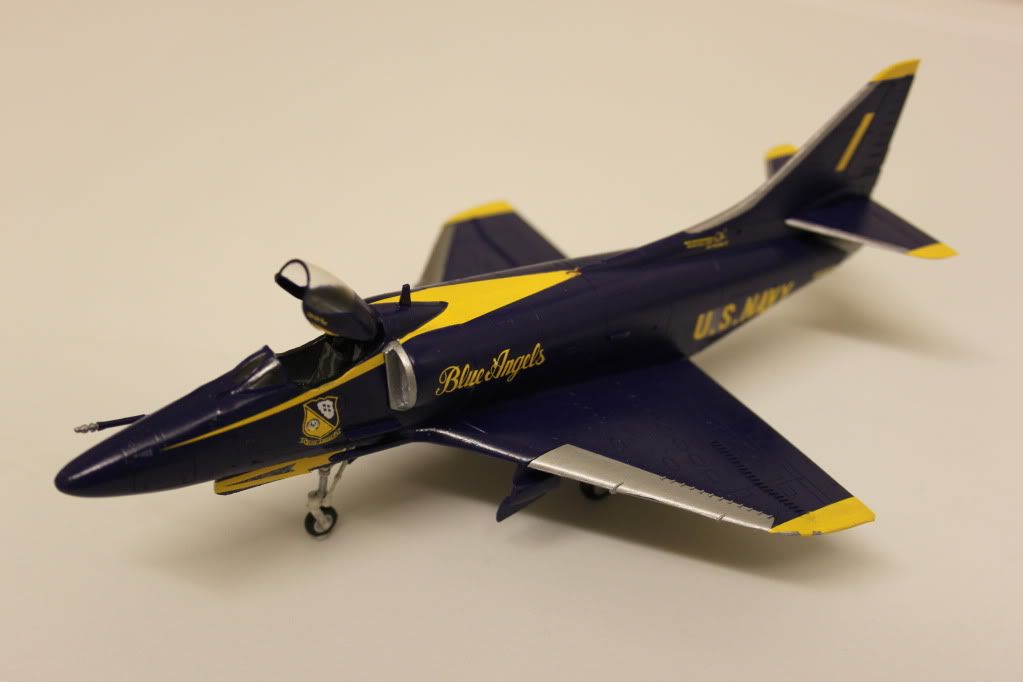

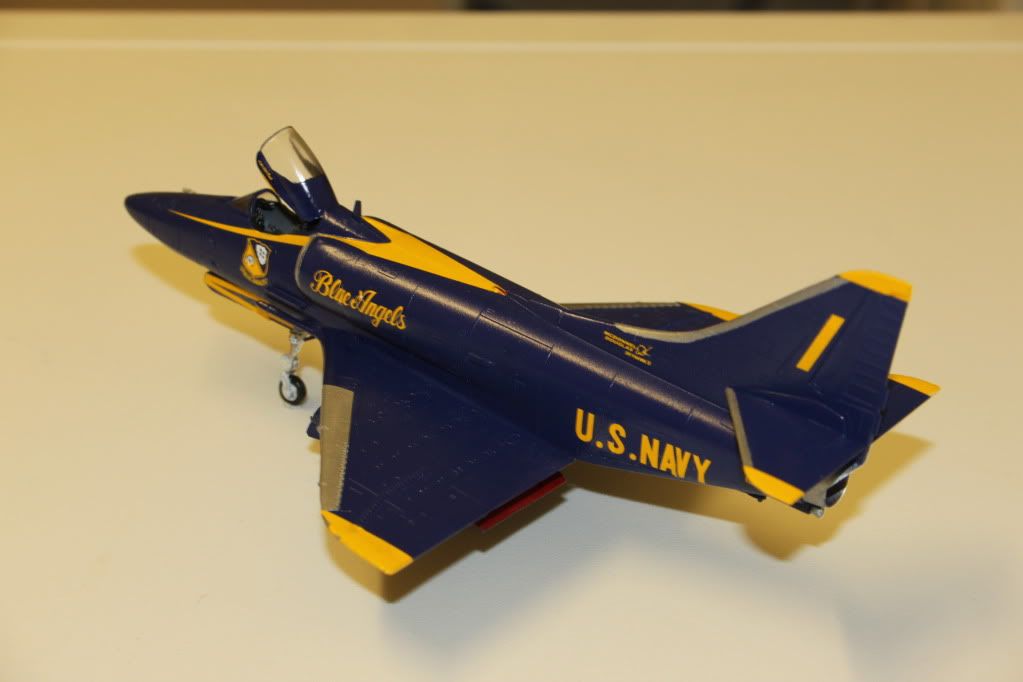
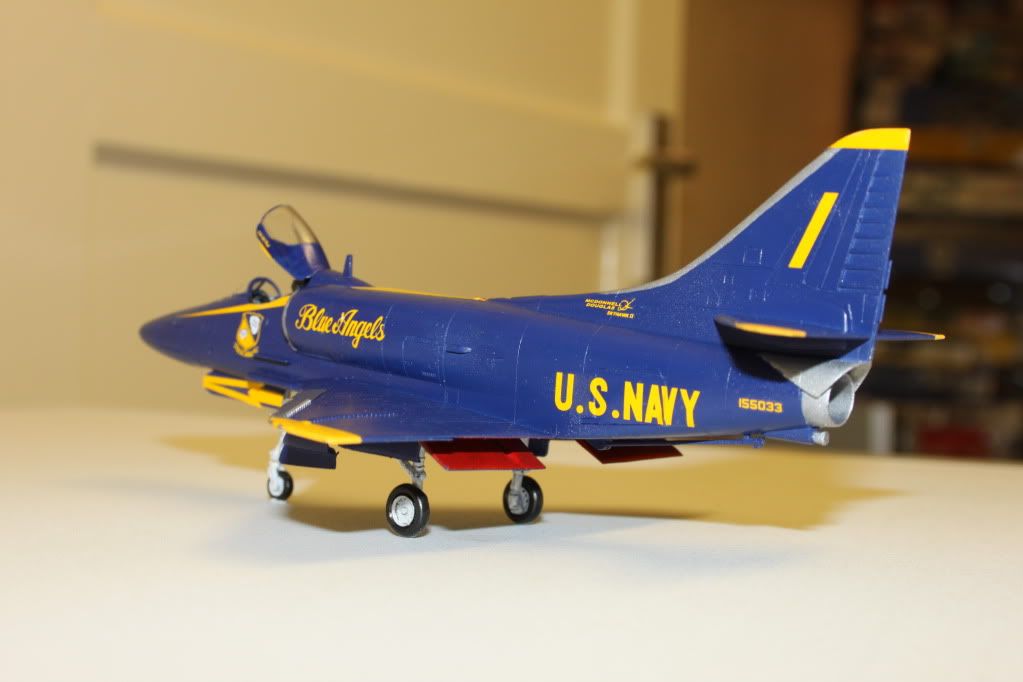
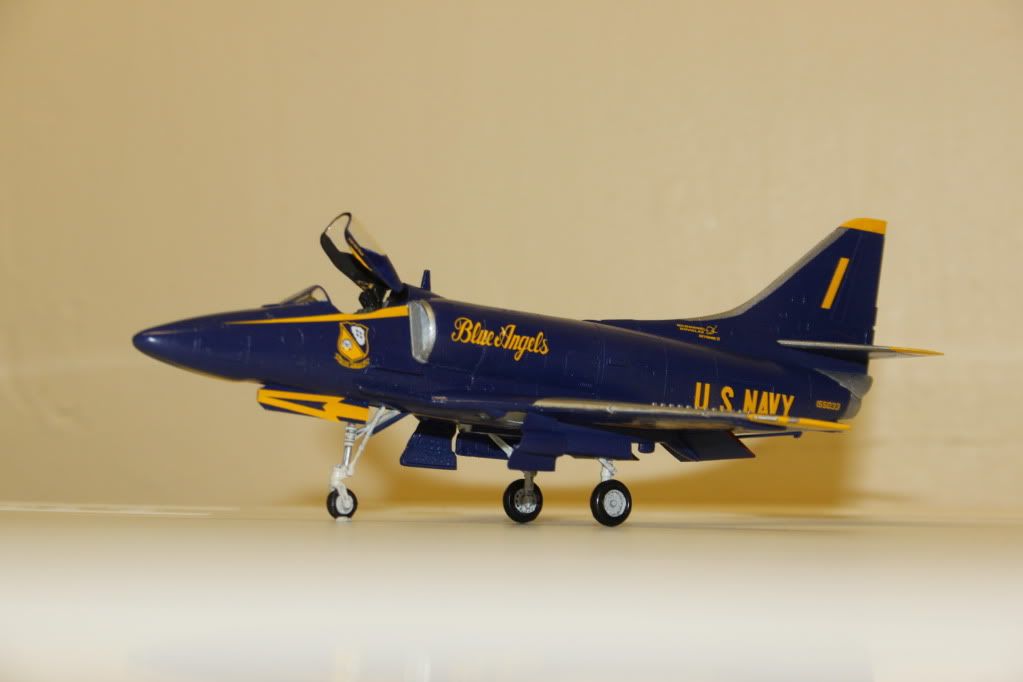
I think I got the blue right with this one. Here it is with its brother.

Added to all of the other builds I did for this GB.
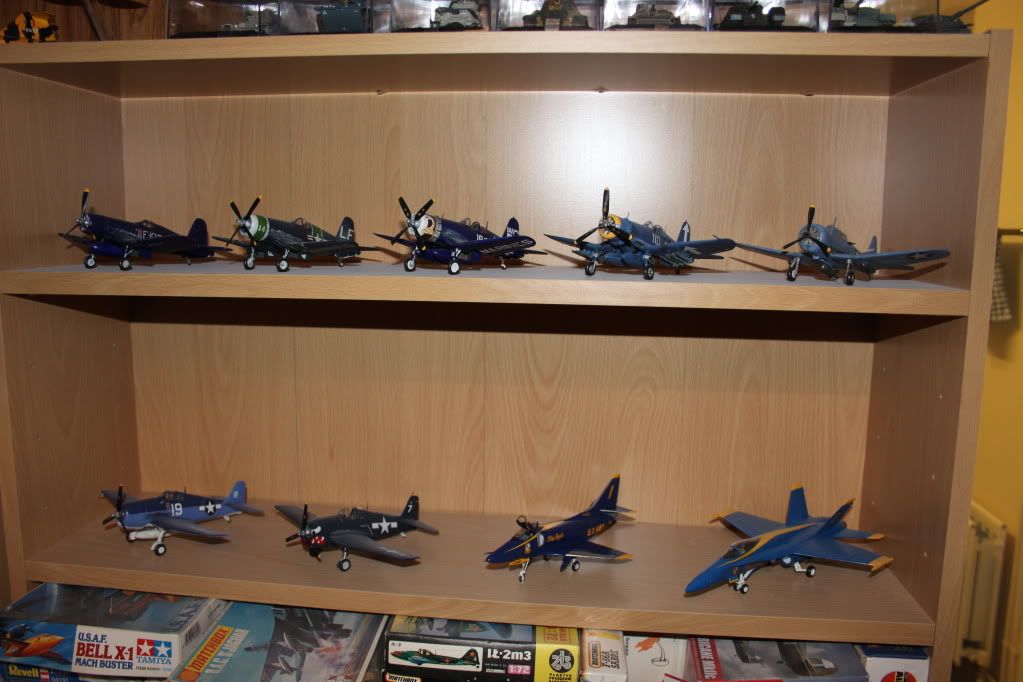





I think I got the blue right with this one. Here it is with its brother.

Added to all of the other builds I did for this GB.

http://stevenharrisongreen.wixsite.com/shgp
facebook.com/stevenharrisongreenphotography
instagram.com/shgphotography86/
facebook.com/stevenharrisongreenphotography
instagram.com/shgphotography86/
Re: USN GB Gallery
OOB, Academy 1/144, F14 of VF114 (nose to tail is 125mm) Decided to do this in flight as the undercarriage was rubbish and the doors would have been about 6 inches thick in scale! Missiles looked pretty naff too. Yes, I know, it's an old Airfix stand - robbed from one of my Hunters.




ex-RAF Hunter, Harrier and Wessex mechanic
-
Flyingmonster
- Moderator
- Posts: 13588
- Joined: Sun Oct 04, 2009 4:16 pm
- Location: Skipton, North Yorkshire
Re: USN GB Gallery
Well I finished the EA6B from Kitech in 72nd  Finished in a mixture of markings due to problems with the Decals!
Finished in a mixture of markings due to problems with the Decals!









Cheers
Boo boo (aka Jamie)
'The first time I ever saw a jet, I shot it down!' - Yeager
Boo boo (aka Jamie)
'The first time I ever saw a jet, I shot it down!' - Yeager
Who is online
Users browsing this forum: No registered users and 2 guests



